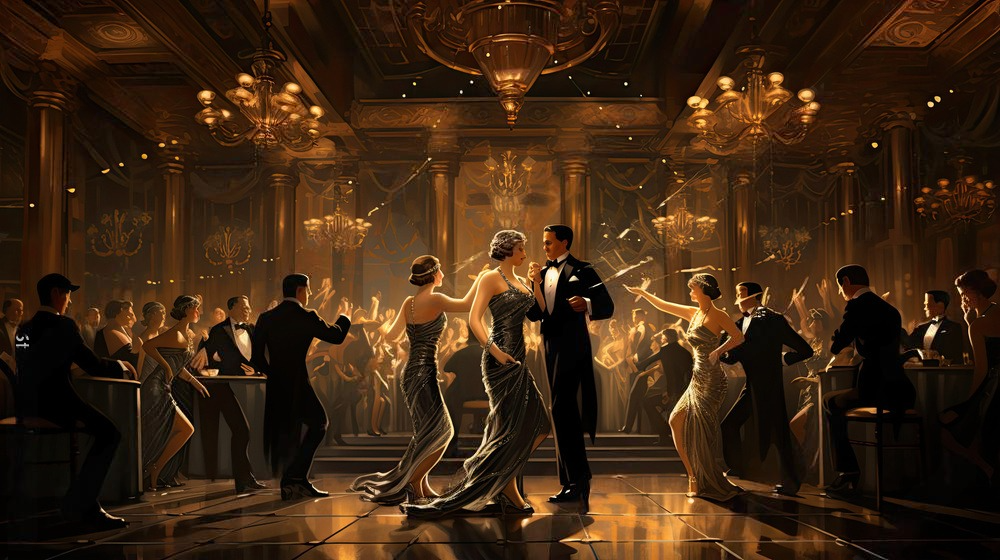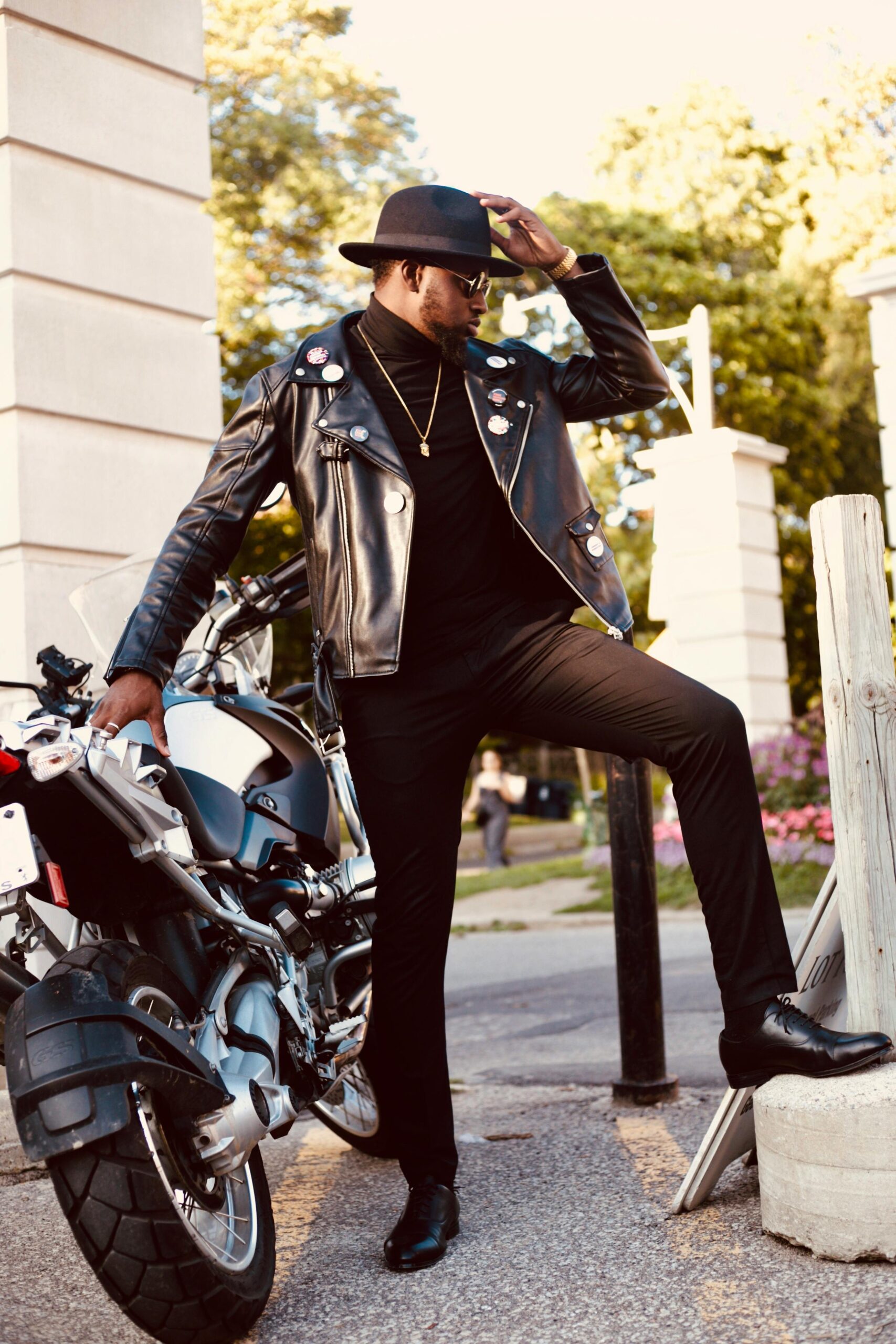Welcome to the Roaring Twenties, a decade that redefined fashion, culture, and societal norms. The 1920s fashion was a period of immense change and innovation, marked by economic prosperity, artistic liberation, and the emergence of the modern woman. This era marked a departure from the rigid constraints of previous decades, as bold new styles emerged, reflecting the spirit of liberation and modernity that defined the era.
Table of Contents
Introduction to 1920s fashion: The Dawn of a New Era
The 1920s, often hailed as the “Roaring Twenties,” was a pivotal period in history marked by cultural dynamism, economic prosperity, and significant shifts in fashion. The 1920s heralded a departure from the rigid constraints of Victorian fashion, embracing a newfound sense of liberation and self-expression. As the aftermath of World War I faded into the background, a wave of optimism swept across the globe, paving the way for a cultural revolution. This shift was reflected in the fashion of the era, characterized by bold silhouettes, lavish embellishments, and a spirit of rebellion.
The Cultural Revolution of 1920s Fashion: Beyond the Beads and Fringe
The 1920s was a decade of significant social, cultural, and economic change and one area where this transformation was particularly evident was in fashion. The cultural revolution of 1920s fashion represents a watershed moment in the history of style and self-expression. From the rise of flappers to the enduring legacy of Coco Chanel, the Roaring Twenties continues to exert a profound influence on contemporary fashion.
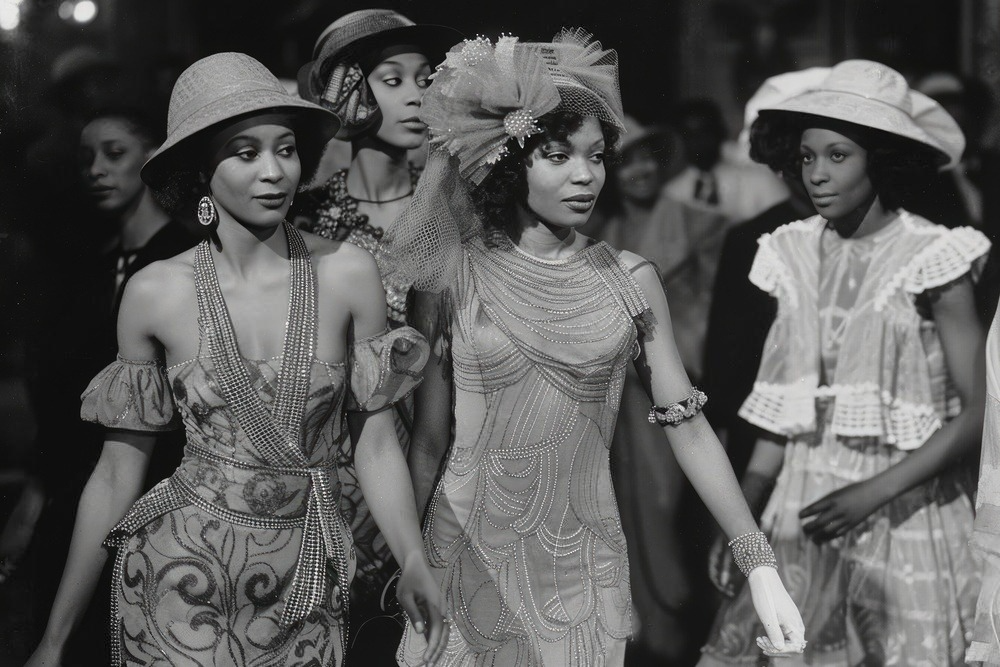
1. The Rise of Flappers
At the forefront of 1920s fashion was the iconic flappers, young women who rebelled against traditional norms with their daring attire and behavior. Flappers embraced a more relaxed silhouette, trading in corsets and long skirts for loose-fitting dresses that allowed for greater freedom of movement. Their short bobbed haircuts and penchant for bold makeup further challenged conventional notions of femininity.
2. Art Deco Aesthetics
The 1920s fashion also witnessed the rise of Art Deco design, characterized by its geometric shapes, sleek lines, and lavish ornamentation. This aesthetic influenced not only fashion but also architecture, interior design, and visual arts, leaving an indelible mark on the era’s cultural landscape. Art Deco-inspired motifs inspire contemporary designers and are celebrated for their timeless appeal.
3. Technological Advancements
Advancements in technology, particularly in the textile industry, played a pivotal role in shaping 1920s fashion. The development of new synthetic fabrics, such as rayon and nylon, paved the way for innovative designs and affordable clothing options. Mass production techniques also democratized fashion, making stylish garments accessible to a wider audience than ever before.
4. The Influence of Hollywood
The burgeoning film industry of the 1920s had a profound impact on fashion, as audiences looked to Hollywood for style inspiration. Silver screen sirens like Clara Bow and Greta Garbo captivated audiences with their glamorous ensembles, setting trends eagerly emulated by fans worldwide. The intersection of celebrity culture and fashion became increasingly pronounced during this period, with movie stars becoming influential arbiters of taste.
5. The Legacy of Coco Chanel
No discussion of 1920s fashion would be complete without mentioning the enduring legacy of Coco Chanel. The pioneering French designer revolutionized women’s fashion with her timeless creations, including the iconic little black dress and the effortlessly chic Chanel suit. Chanel’s emphasis on comfort, simplicity, and elegance continues to shape contemporary fashion, cementing her status as a visionary icon.
6. Fashion as Self-Expression
Above all, 1920s fashion represented a shift towards self-expression and individuality. The clothes people wore became a means of asserting their identity and challenging societal norms. Whether through daring hemlines, vibrant patterns, or innovative accessories, individuals embraced fashion as a form of personal expression, ushering in a new era of sartorial freedom.
7. The Enduring Appeal of Retro Fashion
While the 1920s may belong to a bygone era, its influence on fashion endures to this day. Retro-inspired designs regularly grace the runways, with contemporary designers drawing inspiration from the glamour and sophistication of the Roaring Twenties. From flapper dresses to Art Deco embellishments, elements of 1920s style continue to captivate fashion enthusiasts and serve as a source of creative inspiration.
Women’s Fashion in the 1920s: Chic and Sassy
Women’s fashion during this period underwent a remarkable transformation, reflecting the spirit of liberation, rebellion, and celebration that characterized the decade. The 1920s was a transformative era in the realm of women’s fashion, characterized by innovation and unparalleled creativity. From the liberation of silhouettes to the rise of the iconic flapper, 1920s fashion continues to captivate and inspire, reminding us of the enduring power of style to reflect the spirit of its time.

The Liberation of Silhouettes: From Corsets to Freedom
The 1920s fashion witnessed a significant departure from the restrictive and constricting clothing of the Victorian era. Gone were the days of corsets and petticoats, as women embraced a newfound sense of liberation and independence. The silhouette of the era was defined by a straight, boyish figure, characterized by dropped waistlines and flattened chests. This shift allowed for greater ease of movement and a more relaxed, modern aesthetic.
Embracing Decadence: Fabrics, Colors, and Embellishments
Fabrics played a pivotal role in defining the landscape of 1920s fashion. Luxurious materials such as silk, satin, and velvet were favored for eveningwear, exuding opulence and sophistication. The color palette embraced boldness and vibrancy, with jewel tones like emerald green, sapphire blue, and ruby red dominating the scene. Sequins, beads, and fringe embellishments added an extra touch of glamour to dresses, reflecting the exuberance of the era’s social scene.
Flapper Style: Breaking Traditions
Central to the fashion narrative of the 1920s was the emergence of the “flapper” archetype – a symbol of youthful rebellion, freedom, and modernity. Flappers, with their bobbed hair, daring hemlines, and penchant for risqué behavior, embodied the spirit of the Jazz Age. Their style was characterized by drop-waist dresses adorned with fringe, feathered headbands, and long strands of pearls. The flapper look epitomized the newfound sense of liberation and nonconformity that permeated society during this time.
The Influence of Cinema and Celebrity
The burgeoning film industry and the rise of Hollywood celebrities played a significant role in shaping fashion trends during the 1920s. Screen sirens like Clara Bow and Louise Brooks captivated audiences with their on-screen charisma and distinctive sense of style, influencing the way women dressed and behaved. Their glamorous ensembles on and off the silver screen set the standard for elegance and sophistication, further fueling the desire for fashionable attire among the masses.
Men’s Fashion in the 1920s: The Dapper Decade
While women’s fashion of the era is widely celebrated for its liberation and glamour, men’s fashion also underwent a transformative evolution, reflecting the spirit of the Jazz Age and the changing roles of men in society. The 1920s fashion was a transformative decade for men, characterized by innovation, sophistication, and a newfound sense of freedom and individuality.
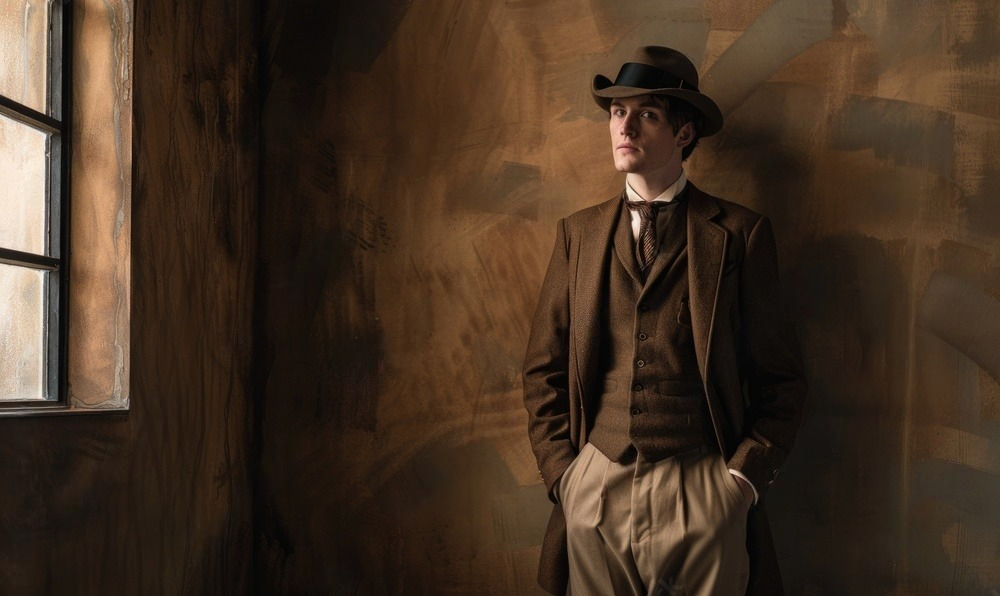
Breaking Away from Tradition: The Revolution of Men’s Clothing
The 1920s fashion witnessed a departure from the conservative styles of previous decades, as men embraced casual fashion style, a more relaxed and laid-back approach to dressing. Gone were the stiff collars and structured suits of the Victorian era, replaced by softer, more comfortable fabrics and looser silhouettes. This shift in menswear reflected the changing attitudes towards masculinity and self-expression, as men sought to break away from tradition and embrace a sense of freedom and individuality in their attire.
The Iconic Suit: A Symbol of Elegance and Sophistication
Despite the move towards casual dressing, the suit remained the cornerstone of men’s fashion in the 1920s. However, it underwent significant changes to adapt to the spirit of the times. Suits became more streamlined and less formal, with shorter jackets and narrower lapels. The popularization of ready-to-wear clothing made suits more accessible to the masses, allowing men from all walks of life to dress with style and elegance.
Embracing Sportswear: From the Golf Course to the Streets
The 1920s fashion saw a rise in the popularity of sportswear-inspired attire, as leisure activities such as golf, tennis, and yachting became increasingly fashionable among the upper classes. This influence trickled down to everyday fashion, with men incorporating elements of sportswear into their daily wardrobes. Items such as knitted sweaters, cardigans, and polo shirts became staples of casual dressing, reflecting the newfound emphasis on relaxation and leisure.
The Influence of Hollywood and Icons on the Silver Screen
The emergence of the Hollywood film industry during the 1920s brought with it a new breed of style icons whose influence extended far beyond the silver screen. Actors like Rudolph Valentino and Douglas Fairbanks captivated audiences with their dashing good looks and impeccable sense of style, setting the standard for men’s fashion of the era. Their on-screen personas, characterized by tailored suits, fedoras, and polished oxfords, inspired men to emulate their sophisticated aesthetic in their own lives.
Accessorizing with Flair: Hats, Ties, and Pocket Squares
Accessories played a crucial role in defining the 1920s fashion of men, adding flair and personality to their ensembles. Hats were an essential accessory for men of all ages, with styles ranging from the classic fedora to the sporty newsboy cap. Neckties were another must-have item, worn in a variety of styles including the narrow “arrow” tie and the wider “butterfly” tie. Pocket squares, cufflinks, and tie bars were also popular accessories, adding a touch of elegance and refinement to a man’s look.
Accessories and Hairstyles of 1920s Fashion: Accessorizing Elegance
The accessories and hairstyles of 1920s fashion were a reflection of the era’s spirit of innovation, liberation, and glamour. In addition to the evolution of clothing silhouettes, accessories, and hairstyles played a pivotal role in defining the sartorial landscape of the Roaring Twenties.
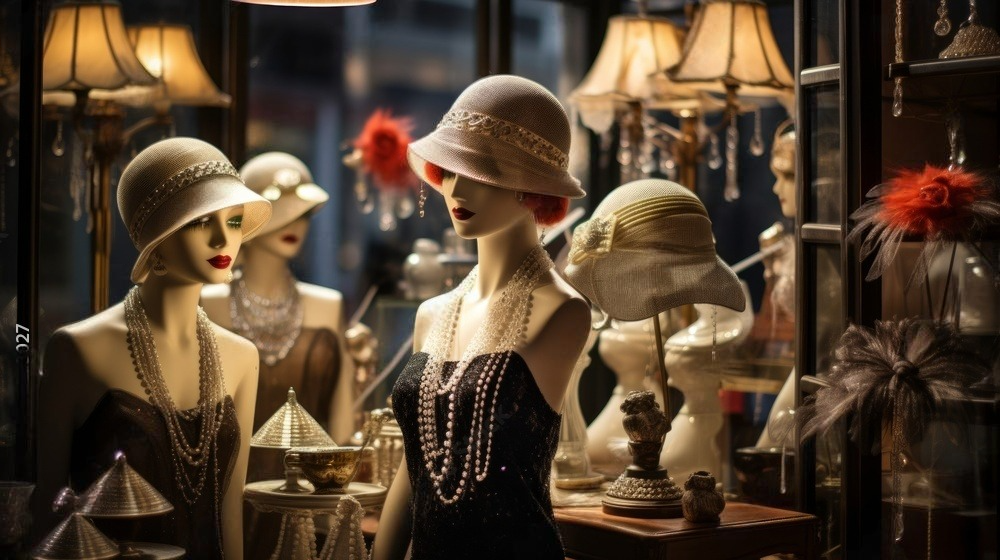
Hats: The Crowning Glory of 1920s Fashion
Hats were an essential accessory for both men and women in the 1920s, adding a touch of elegance and style to any ensemble. For men, the fedora was the epitome of sophistication, with its wide brim and pinched crown exuding timeless charm. Other popular styles included the trilby, the Homburg, and the newsboy cap, each adding a unique flair to men’s fashion of the era.
Women, on the other hand, embraced a variety of hat styles to complement their outfits. The cloche hat, with its close-fitting, bell-shaped design, was particularly fashionable during the 1920s, framing the face in a chic and elegant manner. Other popular styles included the beret, the turban, and the wide-brimmed sun hat, each offering a distinctive look that reflected the wearer’s personality and sense of style.
Jewelry: Sparkling Accents and Art Deco Elegance
Jewelry played a significant role in 1920s fashion, with accessories ranging from delicate pieces to bold, statement-making adornments. The Art Deco movement, with its geometric shapes and bold colors, influenced much of the jewelry design of the era, resulting in pieces that were both striking and elegant.
For women, long strands of pearls were a quintessential accessory, adorning necklines and adding a touch of sophistication to flapper dresses. Art Deco-inspired brooches, bracelets, and earrings featuring geometric motifs and sparkling gemstones were also popular choices, adding a touch of glamour to eveningwear.
Men, too, embraced jewelry as a means of expressing their style. Tie pins, cufflinks, and collar bars were essential accessories for completing a polished look, often featuring Art Deco-inspired designs that mirrored the aesthetic of the era.
Hairstyles: Bobbed Hair and Finger Waves
Hairstyles underwent a dramatic transformation in the 1920s, reflecting the spirit of liberation and modernity that characterized the decade. For women, the bob haircut emerged as a symbol of independence and freedom, with its short length and sleek, angular lines challenging traditional notions of femininity. The bob could be worn with or without bangs and was often styled with finger waves or pin curls for added texture and flair.
Men’s hairstyles also evolved during the 1920s, with shorter, more streamlined cuts replacing the longer, more elaborate styles of previous decades. The slicked-back look, achieved with the use of pomade or hair oil, was a popular choice among fashionable men, offering a sleek and polished appearance that complemented the tailored suits of the era.
The Legacy of 1920s Accessories and Hairstyles
The influence of 1920s fashion accessories and hairstyles can still be seen in contemporary fashion, with many of the era’s trends experiencing a resurgence in popularity. From the timeless elegance of the fedora to the bold, geometric designs of Art Deco jewelry, the accessories of the Roaring Twenties continue to captivate and inspire, reminding us of the enduring allure of vintage style.
Captivating Icons: How Influencers Shaped Trends in the 1920s
Amidst this whirlwind of transformation, several individuals emerged as iconic figures whose sense of style and charisma captivated the imagination of the masses. The icons of 1920s fashion were more than just trendsetters – they were visionaries who shaped the way we think about style and self-expression. From Hollywood starlets to pioneering designers, these fashion influencers left an indelible mark on the sartorial landscape of the era.
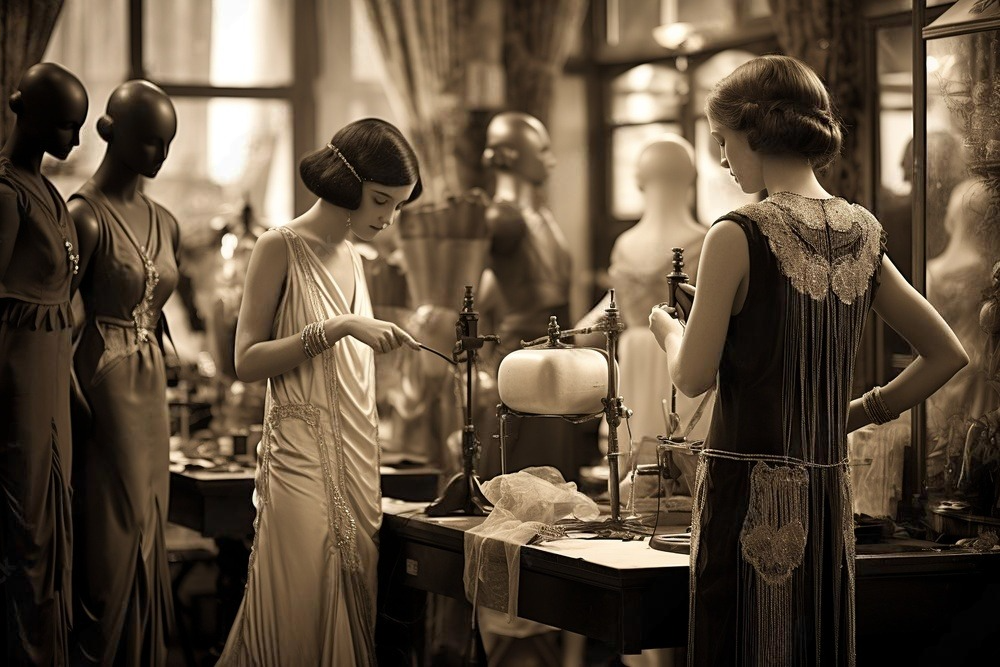
Coco Chanel: A Revolutionary Visionary
No discussion of 1920s fashion would be complete without mentioning Coco Chanel, the pioneering designer who revolutionized the way women dressed. With her avant-garde approach to design and emphasis on comfort and simplicity, Chanel challenged the conventions of traditional fashion, paving the way for a new era of modern elegance. Her iconic creations, including the little black dress, the Chanel suit, and the classic quilted handbag, continue to influence fashion to this day, cementing her status as one of the most influential figures in fashion history.
Louise Brooks: The Epitome of Flapper Chic
Louise Brooks, with her striking bob haircut and smoldering gaze, personified the spirit of the flapper in the 1920s fashion. As one of the era’s most iconic actresses, Brooks captivated audiences with her on-screen charisma and distinctive sense of style. Her signature look – sleek, bobbed hair, bold makeup, and figure-hugging dresses – epitomized the glamour and rebellion of the Jazz Age, inspiring women around the world to embrace a newfound sense of freedom and individuality in their dress and demeanor.
Rudolph Valentino: The Ultimate Heartthrob
Rudolph Valentino, often hailed as the “Great Lover” of the silent film era, was not only a cinematic icon but also a fashion trailblazer. With his dark, brooding good looks and impeccable sense of style, Valentino set the standard for masculine elegance in 1920s fashion. His impeccably tailored suits, accessorized with silk scarves and fedora hats, epitomized the sophistication and refinement of the era, inspiring men to emulate his suave and debonair aesthetic.
Josephine Baker: The Queen of Jazz Age Glamour
Josephine Baker, the legendary entertainer and dancer, captivated audiences with her electrifying performances and avant-garde sense of style. With her flamboyant stage costumes, adorned with feathers, fringe, and beads, Baker embodied the spirit of the Jazz Age like no other. Her daring ensembles and fearless attitude towards fashion challenged societal norms and paved the way for greater acceptance of individuality and self-expression in dress.
Erte: The Master of Art Deco Elegance
Erte, the prolific fashion illustrator, and designer, was synonymous with the Art Deco movement of the 1920s. His exquisite illustrations, characterized by sleek lines, geometric shapes, and bold colors, captured the essence of the era’s aesthetic and influenced fashion and design for decades to come. Erte’s timeless creations, including elaborate evening gowns, statement jewelry, and theatrical costumes, continue to inspire designers and creatives around the world, reminding us of the enduring allure of Art Deco elegance.
The Legacy of 1920s Fashion in 2024: Vintage Vibes, Modern Flair
While the 1920s may have come and gone, its influence on fashion endures, shaping the way we dress and express ourselves to this day. The legacy of 1920s fashion is far-reaching and enduring, shaping the way we dress and express ourselves in the modern world.

Embracing Change: The Evolution of Silhouettes
One of the most significant contributions of 1920s fashion was the liberation of silhouettes. Gone were the restrictive corsets and voluminous skirts of previous eras, replaced by streamlined, boyish shapes that allowed for greater freedom of movement and expression. The shift towards more relaxed, unstructured clothing laid the foundation for modern fashion, emphasizing comfort, versatility, and individuality in dress.
Art Deco Aesthetics in Contemporary Design
The Art Deco movement, which reached its zenith in the 1920s, continues to inspire contemporary design across various industries, including fashion, architecture, and interior design. Characterized by geometric shapes, bold colors, and sleek lines, Art Deco aesthetics lend a sense of glamour and sophistication to modern fashion. From statement jewelry to graphic prints to architectural-inspired silhouettes, the influence of Art Deco design can be seen in the modern reinterpretation of classic styles and motifs.
The Rise of Ready-to-Wear: Fashion for the Masses
The 1920s saw the democratization of fashion, as advances in manufacturing and distribution made stylish clothing more accessible to the masses. The popularization of ready-to-wear clothing allowed people from all walks of life to dress with style and sophistication, regardless of their social or economic status. This democratization of fashion paved the way for the rise of consumer culture and laid the groundwork for the fast-fashion industry that dominates the modern retail landscape.
Gender-Bending Style: Blurring the Lines
1920s fashion challenged traditional notions of gender and identity, with men and women alike embracing styles that defied conventional norms. Women’s adoption of pantsuits and menswear-inspired ensembles signaled a newfound sense of independence and empowerment, while men experimented with softer fabrics and more casual attire, reflecting a shift towards a more relaxed and egalitarian approach to dressing. This blurring of gender boundaries continues to influence contemporary fashion, with designers embracing and celebrating diversity in style and expression.
Sustainable Fashion Movement
As awareness of environmental and ethical issues in the fashion industry grows, there has been a renewed interest in sustainable and ethical practices. This shift towards conscious consumption aligns with the values of 1920s fashion, which emphasized quality over quantity and craftsmanship over mass production. From upcycled vintage clothing to eco-friendly materials to slow fashion brands, the influence of 1920s fashion on the modern sustainable fashion movement underscores a return to timeless style and timeless values.
The 1920s was a decade of unprecedented change and innovation in fashion, marked by the emergence of iconic styles and trends that continue to influence modern-day aesthetics. The impact of 1920s fashion on modern trends is undeniable, shaping the way we dress and express ourselves in the 21st century as 1920 was a decade of cultural dynamism, artistic innovation, and social liberation. It was a time when the boundaries of fashion were pushed to new heights, reflecting the spirit of rebellion, freedom, and modernity that characterized the era.

